HOW WOULD WALLACE HAVE DRESSED? |
| The Society was recently asked how Wallace would have dressed for combat. There is a sad lack of factual pictorial representations of dress in this period (late 13th – early 14th century), and absolutely none of the man himself. So let's just immediately dismiss all of the "Braveheart" bullshit, which bears little or no resemblance to what people actually wore in this period, and concentrate on what is known from the very few period descriptions, some archaeological evidence, and the background and social history of Wallace himself. We know some of his origins, and quite a bit can be deduced from those and the circumstances he found himself in. William Wallace was the second son of a minor knight, in the lower echelons of society. As second son, he would not inherit his father's demesne, unless a fatal accident befell his elder brother. So Wallace was destined for the church, a popular choice for second sons, who benefited from a more formal education and the chance to rise in the ecclesiastical hierarchy and in social prestige. It is recorded that he was undergoing formal education in Dundee, as was his friend and later biographer John Blair. Prior to this, as the son of a knight, no matter how lowly, he would have undergone a degree of arms training, and since his seal bore the emblem of a bow, it is generally believed that he may have been a reasonably accomplished archer. He would have had some training in the use of the sword as well, as befits a knight's son of the period, no matter how minor. So what we have now is a young man, trained to a certain degree in arms, but destined for cloisters, with the education and training required for such a role. Destiny intervenes, he kills the son of the English Constable of Dundee, Selby, and ends up on the run (he's a Scot who has just killed one of the overlord's high-heid-yin's sons, there's only one end to THAT story), fleeing via Kilspindie and Dunfermline to escape the vengeance of the oppressor. So what is he now, other than an outlaw in the eyes of the invader? He's going to have to defend himself, and presumably has already made the choice that he will defend his country against those who would see it diminished. Educated to a reasonable degree, he's obviously got a healthy intelligence, he's a big lad, and he knows how to use weapons, and probably has a degree of tactical awareness from his early arms training. But his father's not rich, and will probably have to visibly "disown" him to ensure the invader's wrath is not wielded against the rest of the family – so what's a poor boy to do? Various stories, legends, and the occasional chronicle pad out pretty much what happened next. But what was he wearing, the fashion-conscious cry? OK, here goes with my best guesses, based on what is known of the period, incidents recorded and required mobility, allied to cash/goods/barter available to someone in his circumstances. |
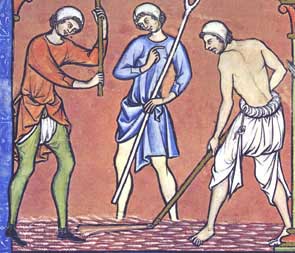 |
|
Let's start with his nether garments, such as they were at the time – this illustration is from a period manuscript. The gentleman on the left is wearing hose, along with a crotch-covering garment, whilst the gentleman on the right is wearing braies, a form of gathered trouser. Middle man is wearing a tunic, presumably over braies as there's no sign of his hose... So this is pretty much the basic regulation kit for anyone from peasant upward (please note all these lads are apparently agricultural workers, pretty low in the pecking order of the times). From here on there's a degree of informed speculation, based on the few known facts and what can be deduced from the available evidence. Now let's have a look at these two strapping lads! Reasonably accurate representations of what the very well-dressed man-at-arms or archer was wearing at the time (but not the peasants!). A little bit fanciful, in that one has a sword and shield, but other than that I'll let them off with it. A good tin lid on the napper, chain mail where appropriate (and if they could afford it), and a gambeson, with tunic and leather accessories. |
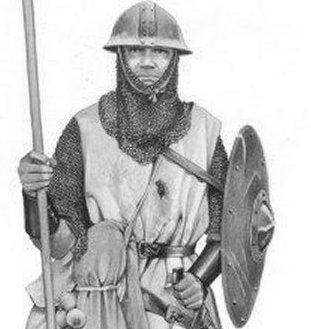 |
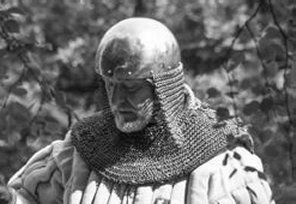 |
Not a bad effort overall. The one below is the archer, and his helmet is quite appropriate for an archer, who would wear a simple helm, and chain mail coif only, with gambeson and leather accessories, keeping in mind their need for agility and movement rather than being heavily armoured. The Scots, sadly, never learned to develop the bow the way the Welsh did. The kettle helm above is pretty close to standard in the Scots formations of the time, as is the long spear. So it's slightly more accurate in the circumstances. Chain mail was expensive, and generally acquired by killing some enemy person wearing it, and then helping yourself. Nobody said war was fair... So Wallace's kit would probably have been closer to that above, and since he could use a sword then he would probably wear it. Not necessarily round the waist however, as if it was a great sword as he was reputed to have carried, on a strap slung on his back, so as to reach behind and grasp as required. The shield would not have been required, as he was known to be an archer, and his sword was a two-hander. It is not known where or when he acquired the sword which is said to have been his. As he rose in importance and leadership, he would undoubtedly have acquired better protective gear and weapons, but at the end of the day he was also required to be extremely mobile and responsive. As such, the idea of him ending up encased in plate armour, complete with shire horse and jousting helm, is positively ludicrous. He would undoubtedly have required to be on horseback at times, and his background demonstrates that this would not have been in any way strange to him, but his periodically nomadic lifestyle would have decidedly ruled against him being accompanied by a full set of plate armour, several squires to strap him into same, and a fine selection of jousting spears. So, not an acknowledged admirer of Longshanks' collection of clankies, then... He was probably clad in a reasonable amount of chain mail but not plate armour. However, most of his battles were fought on foot, not horseback, so I wouldn't state that this is either historically or practically accurate. Nevertheless, back to the chain mail – and one of the main pre-requisites of this is for serious padding underneath it – a garment known as the gambeson. This is best illustrated here: |
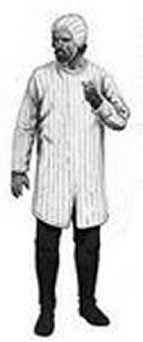 |
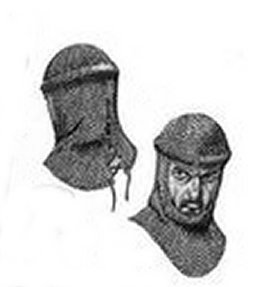 |
The chain mail covered helm and coif is worth thinking about, though. Helm padding, body padding, and protected over all of this by his mail, he now becomes an almost perfect example of how the well-dressed fighter on foot who can afford decent metal protection would go about his gory business. Heavy, requiring a very fit man with a degree of military nous to wear it, and illustrative of how a doughty fighter might be equipped, but nowhere near as restrictive as ludicrously expensive plate armour. Add in some iron strips inside his leather boots to provide shin protection, and it's wearable, gives good overall strike protection (if you don't mind being badly bruised) and both of its time and reasonably available. I think this is pretty close. |
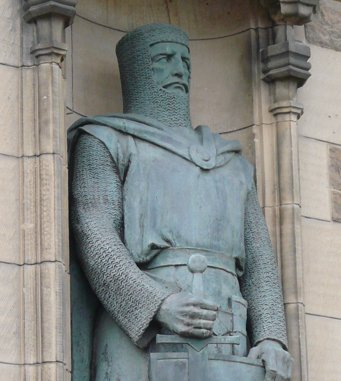 |
All of which brings me to the final picture. Yes, you're right, as displayed on our index page, it's one of the statue of Sir William Wallace by Alexander Carrick, at Edinburgh Castle. The one which allegedly inspired the script writer of the film Braveheart, Randall Wallace... Just a pity he didn't have a bit more control over the final product, because at the end of the day I think this is about as close as we may get to what our man was actually wearing! |
| © Society of William Wallace 2007-2025 | The Society of William Wallace is a Scottish Charitable Incorporated Organisation Registration number SC045959 |
